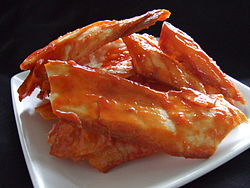 | |
| Alternative names | Keripik sanjay |
|---|---|
| Course | Snack |
| Place of origin | Indonesia |
| Region or state | Bukittinggi, West Sumatra |
| Created by | Minangkabaus |
| Serving temperature | Room temperature |
| Main ingredients | Deep fried dried cassava chips coated with sugar and chili pepper paste |
Keripik sanjai or keripik sanjay (Jawi: كاروڤواق سنجاي; Minangkabau: karupuak sanjai) is a Minangkabau cassava kripik or chips from Bukittinggi city in West Sumatra, Indonesia.[1] It made from thinly sliced cassava deep fried in ample of coconut oil until crispy. It is commonly called keripik singkong in Indonesia, but this Minang version is probably the most popular of keripik singkong in Indonesia. And yet, the sweet, hot and spicy keripik sanjai balado is also the most famous variant of keripik sanjai.
There are three types of kripik sanjai:
- Keripik sanjai tawar is a plain variant that only add salt for flavour
- Keripik sanjai saka is sweet tasting variant coated with palm sugar.
- Keripik sanjai balado, coated with balado bumbu made from the mixture of ground palm sugar and red chili pepper paste, it is the most famous variant.
See also[edit]
References[edit]
- ^ ""Kriuk"... Sanjai di Bukittinggi" (in Indonesian). Kompas.com. 23 August 2013. Retrieved 10 April 2014.
Well, that’s interesting to know that Psilotum nudum are known as whisk ferns. Psilotum nudum is the commoner species of the two. While the P. flaccidum is a rare species and is found in the tropical islands. Both the species are usually epiphytic in habit and grow upon tree ferns. These species may also be terrestrial and grow in humus or in the crevices of the rocks.
View the detailed Guide of Psilotum nudum: Detailed Study Of Psilotum Nudum (Whisk Fern), Classification, Anatomy, Reproduction